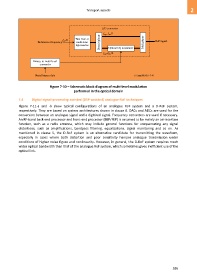Page 605 - 5G Basics - Core Network Aspects
P. 605
Transport aspects 2
E/O converter
f – f /2
ele
opt
f /2 Two-tone or
ele
Reference frequency multi-tone Demultiplexer Multiplexer RoF signal
light source Optical I/Q modulator
f + f /2
opt
ele
Binary-to-multi-level
converter
Serial binary data G Suppl.55(15)_F7-10
Figure 7-10 – Schematic block diagram of multi-level modulation
performed in the optical domain
7.4 Digital-signal-processing-assisted (DSP-assisted) analogue RoF techniques
Figure 7-11-a and -b show typical configurations of an analogue RoF system and a D-RoF system,
respectively. They are based on system architectures shown in clause 6. DACs and ADCs are used for the
conversion between an analogue signal and a digitized signal. Frequency converters are used if necessary.
An RF-band back-end processor and front-end processor (BEP/FEP) is assumed to be mainly an air-interface
function, such as a radio antenna, which may include general functions for compensating any signal
distortions, such as amplifications, bandpass filtering, equalizations, signal monitoring and so on. As
mentioned in clause 5, the D-RoF system is an alternative candidate for transmitting the waveform,
especially in cases where both distortion and poor sensitivity hamper analogue transmission under
conditions of higher noise figure and nonlinearity. However, in general, the D-RoF system requires much
wider optical bandwidth than that of the analogue RoF system, which sometimes gives inefficient use of the
optical link.
595

